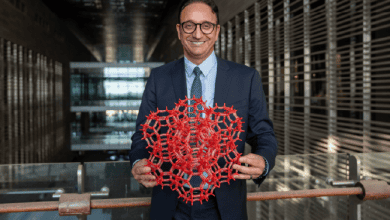Khalil Amine: Pioneering Electric Vehicle Batteries

عندما نفكر في العلماء وأبحاثهم، نتخيل المفاهيم النظرية التي تزدهر في بيئة المختبر، ولكنَّ هذا لا ينطبق على خليل أمين، الحائز «جائزة الكويت للعلوم التطبيقية» للعام 2022، من مؤسسة الكويت للتقدم العلمي. يعمل أمين في مجال تكنولوجيا تخزين الطاقة – في الغالب تقنيات البطاريات المتقدمة – على مستوى المواد والأنظمة للتطبيق في السيارة الكهربائية والشبكة الذكية. ولكنْ يمكن تطبيق هذه التكنولوجيا – أيضاً – على الإلكترونيات الاستهلاكية، والأجهزة الطبية، والأقمار الاصطناعية، والتطبيقات العسكرية، وذلك من بين جملة من التطبيقات الأخرى.
Amine completed his bachelor’s degree at the University of Marrakech in Morocco, followed by a master’s and doctorate from the University of Bordeaux in France. He then undertook postdoctoral studies in Brussels, Belgium. After finishing his education, he moved to Japan in 1990, coinciding with Sony’s launch of the first commercial rechargeable lithium-ion battery. “It was the best time to be in Japan,” Amine recalls, “as many scientists were looking into this new lithium-ion battery technology.” He began exploring the potential for batteries in electrical vehicles (EV), a field that posed new challenges.
While consumer electronics may have a lifespan of two or three years, electric vehicles last around 15 years. Amine notes that this requires batteries that are stable, powerful, energy-dense, and low-cost. He started his research at Kyoto University and also joined the Osaka National Research Institute. During this time, he invented the first 5V cathode, now used globally in grid applications and 48V systems.
Amine’s breakthrough with 5V batteries led to his recruitment at Argonne National Laboratory (ANL) in the U.S., where he was tasked with building a team and advancing battery research. ANL, he says, has the latest equipment and the brightest minds in the field. There, Amine co-invented the NMC cathode material, now widely used in electric vehicles globally. His innovation has contributed significantly to reducing greenhouse gas emissions by driving the mass electrification of vehicles. Amine has authored over 700 papers and holds more than 200 patents, in collaboration with his team. In keeping with ANL’s practice, any innovation is patented before publication.
Approximately 30 of his patents have been licensed and commercialized. Amine actively promotes his technology to ensure that his innovations reach the real world. “He is one of the most unique individuals I have met, who not only does world-class research but also innovates and provides solutions for industry and battery makers globally,” said Jud Virden, Associate Director of Pacific Northwest National Laboratory. “Khalil has the ability to ask, ‘what are the most important problems that the industry is dealing with? What world- class research can I do to address them?’ Then, those solutions are provided to the industry.”
Amine also leads several successful global conferences, regularly bringing together top scientists and key players in the automotive battery space. A recipient of the 2019 Global Energy Prize, Amine’s passion for invention and science began at a young age, a drive he attributes to his father, a professor of Arabic language who placed great importance on education. Amine’s broad studies in chemistry and material sciences have been instrumental in his prolific career as an inventor. He combines his expertise in fluorine chemistry, carbon chemistry, superconductors, physics, and intercalation chemistry to develop materials that stabilize battery chemistry, create new electrode and electrolyte materials, and design novel battery systems.
Though now a U.S. citizen, Amine retains a strong connection to Morocco and is passionate about supporting its people. He facilitates opportunities for Moroccan students to conduct research at top institutions around the world, including at Virden’s lab. Morocco is striving to meet its clean energy goals, and Amine plays a key role in fostering connections and advancing research that aligns with this vision.
As global discussions on batteries inevitably turn to electrification and EVs, Amine stresses the need for a system that is highly sustainable, low-cost, and easy to use. The current target cost for batteries is around $190 per kWh, with a goal to reach $100 by 2025. Achieving a price as low as $70 or $80 per kWh could lead to cost parity between conventional and electric cars, increasing the number of electric cars from 5 million today to 30 million by 2030.
Currently, Amine is working on energy-dense batteries based on oxygen and sodium, a concept already published in Nature Energy. Post-publication collaborations have accelerated the system's development, and Amine hopes it may be commercially available within 10-15 years. He assures that the reaction in these batteries is reversible, meaning oxygen is not continuously consumed but also released back into the atmosphere.
However, Amine is not focusing on just one system. He and his team are also working on sulfur, solid-state batteries, sodium-ion batteries, and more. His primary focus remains on technologies that go beyond lithium-ion, and he hopes to see the air-lithium or air-sodium systems he has invented reach commercial viability within his lifetime.
By Shweta




